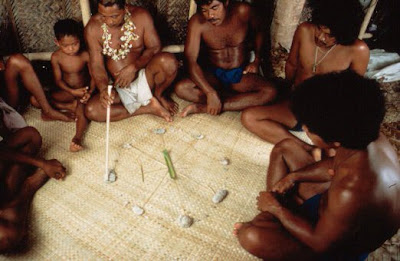
Mau Piailug : Last of the Pacific Navigators Finds his Way HomeJul 13, 2010 Brien Foerster
The last of the old traditional way finding navigators of the Pacific, Mau Piailug, died July 12, 2010, on his home island, Satawal.
When European explorers first ventured into the Pacific in the early 1500s, they found people on all the major islands. How the people got there was a mystery to them. They had no idea that they had happened upon a people who were the greatest explorers and navigators in the world; a people so skilled that they needed no maps or instruments to find their way across the vast ocean.
The last of these great traditional navigators, Mau Piailug, who guided the Hawaiian voyaging canoe Hokule'a on its first trip to Tahiti, using only non-instrument navigation in 1976, died on July 12, 2010, on the island of his birth, Satawal, in Micronesia.
The Education of the Navigator
Mau Piailug was born in 1932 on Satawal, a tiny Pacific island no wider than a mile in Micronesia. When he was still a little baby, his grandfather put him in a tide pool as though he were putting him in a cradle. There the sea gently rocked him back and forth with the rhythm of the tides.
When Mau was six, his grandfather began to teach him about navigation. He started by telling him about the stars; the grandfather made a star compass out of a circle of coral rocks, and in the center he put a little canoe he had made of palm fronds. Then he explained how the stars rose in the sky and traveled from east to west.
As he grew older, Mau spent his evenings in the canoe house. There he asked the elders to teach him about navigation. In this way, and with his grandfather's help, he learned the paths of more than a hundred stars. He also learned that when clouds covered the sky, he could use the direction of the ocean waves to guide the canoe. He could also follow the birds toward land when they headed home in the evening, and he studied the creatures of the sea, for in times of trouble they, too, could help him find land.
At the age of 11 or 12, he was so eager to learn that he was sent to a master navigator, a Palu, who lived on a nearby island. And when Mau was 18 or so he was made a Palu, too, in a special ceremony called Pwo.
For the next 20 years, Mau sailed his canoe in the old way. He fished, and he raised a family. He took pride in being a Palu, but during those years Satawal was changing. An elementary school was built on the island, and the children turned to books instead of their elders for learning.
They no longer came to the canoe house to seek wisdom, and the Pwo ceremony was stopped. On island after island across the Pacific, the old navigators died without passing on their knowledge. And Mau was now afraid that this would happen on Satawal, too.
In 1974 he was invited by the Polynesian Voyaging Society of Hawaii to assist them in reviving the ancient art and science of Hawaiian way-finding. As oral tradition and even archaeological evidence had shown, the Hawaiians had come from Tahiti as far back as the 12th century, if not the time of Christ.
Many western scholars had suggested that the discovery of Hawaii had been accidental, that a canoe had been blown off course. Hawaiian oral tradition knew better; they have a complete geneology going back to when the great voyager Hawai'iloa, along with his navigator Makali'i had first set foot on Hawaiian soil.
Indeed, Captain James Cook was only able to "discover" Aotearoa (New Zealand) and Hawaii with the aid of traditional navigators from the island of Raiatea in Tahiti, who sailed with Cook and guided him to these islands. Cook had blank charts of the areas, and the navigators held the knowledge of the precise locations of them in their minds.
Renaissance of Hawaiian Voyaging
Mau was asked to navigate the Hokule'a; it was an honor, but he did not know if he could make the 2,500-mile journey to Tahiti. He was unfamiliar with the seas, the winds, or even the stars that far south. A visit was made to the local planetarium in Honolulu, where Mau could look at the star map overhead and memorize the positions of those stars that would guide him and the crew of Hokule'a safely to Tahiti.
For 33 days, from May 1 to June 4, 1976, Mau seemed never to sleep. He watched the changing colours of the sky and the sea; he felt the temperature of the air and the water, and he tasted the saltiness of the ocean and listened to the sound of the waves slapping against the hull.
When the Hokule'a arrived safely in Tahiti, reporters spread the news around the world. The successful voyage not only bolstered the pride of the Hawaiians, but all of the people of the Pacific whose ancestors could smile, knowing that their knowledge was alive and growing.
He spent the majority of his final years back home on Satawal. To say that he will be missed is obvious; to say that he acted as a bridge of knowledge from the past to the future is accurate; and to say that he was a great man with a gentle heart and a mind that was a navigational computer is true.
The following are the words of an ancient Satawal chant, telling the people to accept the gifts of the past and be ready to pass them on :
'I will reach behind.
I will reach ahead.'
Sources:
www.hokuleawwv.org/about-voyage/worldwide-voyage/inspiration/mau-piailug
pvs.kcc.hawaii.edu/index/our_founders_our_teachers.htmlRead more at Suite101: Mau Piailug : Last of the Pacific Navigators Finds his Way Home http://news.suite101.com/article.cfm/mau-piailug--the-last-star-navigator-finds-his-way-home-a261042#ixzz0v5wo2mtC


